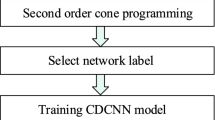Abstract
We propose two-stage null-steering direction-of-arrival (DoA) estimation of ultra wideband (UWB) signals with power inversion algorithm and complex spatio-temporal neural network (CVSTNN). This method can estimate DoA more accurately than conventional methods in narrowband interference (NBI) environment. For null steering in UWB systems, it is necessary to adjust the amplitude and phase of tapped delay lines (TDLs) of CVSTNN. However, with a conventional CVSTNN, it often fails to estimate the arrival direction because of the NBI. We aim to reduce the influence of NBI in the learning process to avoid falling into a local solution by setting the initial weights of the TDLs with power inversion. In simulation results, it is shown that the two-stage method can realize higher DoA estimation accuracy than conventional methods.
















Similar content being viewed by others
Explore related subjects
Discover the latest articles, news and stories from top researchers in related subjects.References
Van Veen BD, Buckley KM (1988) Beamforming: a versatile approach to spatial filtering. IEEE ASSP Mag 5:4–24
Capon J (1969) High-resolution frequency-wavenumber spectrum analysis. Proc IEEE 57:1408–1418
Schmidt R (1986) Multiple emitter location and signal parameter estimation. IEEE Trans Antennas Propag 34:276–280
Roy R, Kailath T (1989) ESPRIT-estimation of signal parameters via rotational invariance techniques. IEEE Trans Acoust Speech Signal Process 37:984–995
Hirose A (1994) Fractal variation of attractors in complex-valued neural networks. Neural Process Lett 1:6–8
Hirose A (2012) Complex-valued neural networks, 2nd edn. Springer, Berlin
Rakkiyappan R, Cao J, Velmurugan G (2015) Existence and uniform stability analysis of fractional-order complex-valued neural networks with time delays. IEEE Trans Neural Netw Learn Syst 26:84–97
Yang WH, Chan KK, Chang PR (1994) Complex-valued neural network for direction of arrival estimation. Electron Lett 30:574–575
Fonseca N, Coudyser M, Laurin JJ, Brault JJ (2010) On the design of a compact neural network-based DOA estimation system. IEEE Trans Antennas Propag 58:357–366
Suksmono AB, Hirose A (2005) Beam forming of ultra-wideband pulses by a complex-valued spatio-temporal multilayer neural network. Int J Neural Syst 15:85–91
Terabayashi K, Natsuaki R, Hirose A (2014) Ultrawideband direction-of-arrival estimation using complex-valued spatiotemporal neural networks. IEEE Trans Neural Netw Learn Syst 25:1727–1732
Compton RT (1979) The power-inversion adaptive array: concept and performance. IEEE Trans Aerosp Electron Syst AES 15:803–814
Kikuta K, Hirose A (2016) Narrowband interference mitigation in UWB systems utilizing frequency dependence of null formation in array antennas. IEEE Access 4:8715–8720
Author information
Authors and Affiliations
Corresponding author
Additional information
A part of this work was presented at International Conference on Neural Information Processing (ICONIP) 2016 Kyoto.
Rights and permissions
About this article
Cite this article
Kikuta, K., Hirose, A. Direction-of-Arrival Estimation of Ultra-Wideband Signals in Narrowband Interference Environment Based on Power Inversion and Complex-Valued Neural Networks. Neural Process Lett 47, 921–933 (2018). https://doi.org/10.1007/s11063-017-9669-4
Published:
Issue Date:
DOI: https://doi.org/10.1007/s11063-017-9669-4




